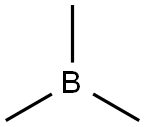TRIBUTYLBORANE
Synonym(s):TBB;Tributylboron
- CAS NO.:122-56-5
- Empirical Formula: C12H27B
- Molecular Weight: 182.15
- MDL number: MFCD00009423
- EINECS: 204-554-6
- SAFETY DATA SHEET (SDS)
- Update Date: 2025-01-27 09:38:02

What is TRIBUTYLBORANE?
Chemical properties
Colorless pyrophoric fluid. Insoluble in water; soluble in most organic solvents.
The Uses of TRIBUTYLBORANE
Tributylborane is a reducing agent used in the controlled radical polymerization of alkyl acrylates.
The Uses of TRIBUTYLBORANE
Petrochemical industry, organic reactions, catalyst.
Synthesis Reference(s)
The Journal of Organic Chemistry, 51, p. 427, 1986 DOI: 10.1021/jo00354a002
Tetrahedron Letters, 26, p. 4311, 1985 DOI: 10.1016/S0040-4039(00)98721-5
Hazard
Flammable, dangerous fire risk, store and use in inert atmosphere, ignites spontaneously in air.
Safety Profile
Poison by intravenous route. Moderately toxic by ingestion. A very dangerous fire hazard when exposed to heat or flame; can ignite spontaneously. When heated to decomposition it emits acrid smoke and irritating fumes. See also BORANES.
Properties of TRIBUTYLBORANE
| Melting point: | -34 °C |
| Boiling point: | 109 °C20 mm Hg(lit.) |
| Density | 0.834 g/mL at 25 °C |
| refractive index | 1.4285 |
| Flash point: | 1 °F |
| storage temp. | Flammables area |
| solubility | Benzene, Tetrahydrofuran |
| form | Solution |
| color | Clear colorless to light yellow |
| Water Solubility | Not miscible or difficult to mix with water. |
| Sensitive | Air Sensitive |
| Exposure limits | ACGIH: TWA 50 ppm; STEL 100 ppm (Skin) OSHA: TWA 200 ppm(590 mg/m3) NIOSH: IDLH 2000 ppm; TWA 200 ppm(590 mg/m3); STEL 250 ppm(735 mg/m3) |
| CAS DataBase Reference | 122-56-5 |
| EPA Substance Registry System | Borane, tributyl- (122-56-5) |
Safety information for TRIBUTYLBORANE
| Signal word | Danger |
| Pictogram(s) |
 Flame Flammables GHS02  Corrosion Corrosives GHS05  Exclamation Mark Irritant GHS07 |
| GHS Hazard Statements |
H250:Pyrophoric liquids; Pyrorophoric solids H302:Acute toxicity,oral H314:Skin corrosion/irritation |
| Precautionary Statement Codes |
P210:Keep away from heat/sparks/open flames/hot surfaces. — No smoking. P280:Wear protective gloves/protective clothing/eye protection/face protection. P231+P232:Handle under inert gas. Protect from moisture. P301+P312:IF SWALLOWED: call a POISON CENTER or doctor/physician IF you feel unwell. P303+P361+P353:IF ON SKIN (or hair): Remove/Take off Immediately all contaminated clothing. Rinse SKIN with water/shower. P305+P351+P338:IF IN EYES: Rinse cautiously with water for several minutes. Remove contact lenses, if present and easy to do. Continuerinsing. |
Computed Descriptors for TRIBUTYLBORANE
| InChIKey | CMHHITPYCHHOGT-UHFFFAOYSA-N |
TRIBUTYLBORANE manufacturer
Sainor Laboratories Pvt Ltd Unit III
1Y
Phone:+91-9182033729
Whatsapp: +91-9666644167
product: 122-56-5 Tributylborane 1.0M in THF 1.0M
New Products
Indole Methyl Resin tert-butyl 9-methoxy-3-azaspiro[5.5]undecane-3-carboxylate Boc-His(Boc)-OH 2-CTC Resin 4-Chloro-7-tosy1-7Hpyrrolo[2,3-d]pyrimidine 5,7-Dibromo-1H-indole 2,5-dichloro-N-hydroxy-4,6-dimethylpyridine-3-carboximidamide 2,2-Dimethoxy-7-azaspiro[3.5]nonane hydrochloride 4-chloromethyl-5-methyl-1,3-dioxol-2-one (DMDO-Cl) R-2-BENZYLOXY PROPIONIC ACID 1,1’-CARBONYLDIIMIDAZOLE 1,1’-CARBONYLDI (1,2-4 TRIAZOLE) N-METHYL INDAZOLE-3-CARBOXYLIC ACID 4-((2-hydroxyethyl)thio)benzoic acid 1-(TERT-BUTOXYCARBONYL)-2-PYRROLIDINONE Methyl 6-methylnicotinate 3-Pyridineacrylic acid tert-Butyl carbazate TETRAHYDRO-2H-PYRAN-3-OL 2-((4-morpholinophenylamino) (methylthio) methylene) malononitrile 3-(4-morpholinophenylamino)-5-amino-1H-pyrazole-4-carbonitrile 2,4-dihydroxybenzaldehyde 1,3-Diethyl-1,3-Diphenylurea Methyl 2-methylquinoline-6-carboxylateRelated products of tetrahydrofuran








You may like
-
 Tributylborane, 1M Solution in Tetrahydrofuran CAS 122-56-5View Details
Tributylborane, 1M Solution in Tetrahydrofuran CAS 122-56-5View Details
122-56-5 -
 Tributylborane, 1m Soln. In ThfView Details
Tributylborane, 1m Soln. In ThfView Details
122-56-5 -
 122-56-5 Tributylborane 1.0M in THF 1.0MView Details
122-56-5 Tributylborane 1.0M in THF 1.0MView Details
122-56-5 -
 Pyridine 99.5% HPLC /UV SpectroscopyView Details
Pyridine 99.5% HPLC /UV SpectroscopyView Details
110-86-1 -
 Piperazine Spot supply, best priceView Details
Piperazine Spot supply, best priceView Details
110-85-0 -
 Dibutyl PhthalateView Details
Dibutyl PhthalateView Details
84-74-2 -
 Imidazole Spot supply, competitive priceView Details
Imidazole Spot supply, competitive priceView Details
288-32-4 -
 Thiourea 99% ARView Details
Thiourea 99% ARView Details
62-56-6
Statement: All products displayed on this website are only used for non medical purposes such as industrial applications or scientific research, and cannot be used for clinical diagnosis or treatment of humans or animals. They are not medicinal or edible.
